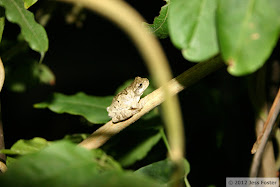 |
| Look how the pupil is dilated to take in as much light as possible for night vision. |
 |
| Remember I said the frog had 3 toes? Well, in this shot you can see 4! I stand corrected. At this point she was doing all she could to get away from my menacing lantern. |
 |
| That 4th toe is hidden again. |
Now, there's a story behind these photos. Ever since declaring this frog to be a Gray Tree Frog, I was anxious about having made a mistake. The Gray Tree Frog is supposed to have a streak of bright yellow or orange on its inner thigh; you can't see this marking unless its leg is straightened out. And I couldn't see it in any of the photos. I hoped to see it when she jumped, but her legs came together so quickly that I never got a chance. So I decided to capture her. I hated doing it, confining her to a Styrofoam cup like I did, but it was the only way to be sure I had the right species. The whole thing was really quite comical, though. To minimize the chance that she'd escape (the last thing we needed was a frog loose in the house with 2 dogs and a cat, and a tiny frog at that), I closed myself in the bathroom and let her out in my hand over the sink. Being an amphibian, she was cold to the touch and was urinating out of fear. Well, I held her body gently between my thumb and forefinger, and used my other hand to straighten out one of her hind legs. Sure enough, there was the yellow streak, but it wasn't very bright or mottled, not like the images I'd seen online. I'm wondering how much variation there is in the brightness. The Gray Tree Frog can be between 1.25 to 2.5 inches in size, which is about how big this one was. Also, the black markings on its back, the bands on its legs, the white patch under its eyes, etc. all point to this species. I suppose the coloring on the thighs differs from individual to individual. Anyway, the poor thing was terrified of me, and eventually she wouldn't leave the cup even when I put it close to the arbor she was perched on originally. At last, however, she hopped out, sufficiently traumatized.
Another note: there are 3 different species of this frog: (Cope's) Gray Tree Frog (Hyla chrysoscelis), Common Gray Tree Frog (Hyla versicolor), and a hybrid combining the Hyla chrysoscelis and the Hyla avivoca (Bird-voiced). The best way to tell the difference between them is the call, but since my frog wasn't in the mood for singing, I had to identify her the hard way. Of these 3, I believe the most likely species is Hyla chrysoscelis, because it is more common than Hyla versicolor in the Piedmont area of the Carolinas. Apparently Hyla versicolor prefers higher elevations and would most likely be found in the mountains.
One more note: this species can change color like a chameleon, only slower.
Here are some sites I used: http://wwknapp.home.mindspring.com/docs/gray.tfrogs.html and http://www.discoverlife.org/mp/20q?search=Hyla+chrysoscelis.
Wow, it's still so tempting to attribute another species, such as Hyla avivoca (Bird-voiced Tree Frog), to this frog, simply because of that pesky yellow coloring on its thigh. But the Hyla avivoca prefers swamps, and I don't believe it would come this far north into a drier, more mountainous area. For now, I'm going to say it's a Hyla chrysoscelis until I find evidence to the contrary.





No comments:
Post a Comment